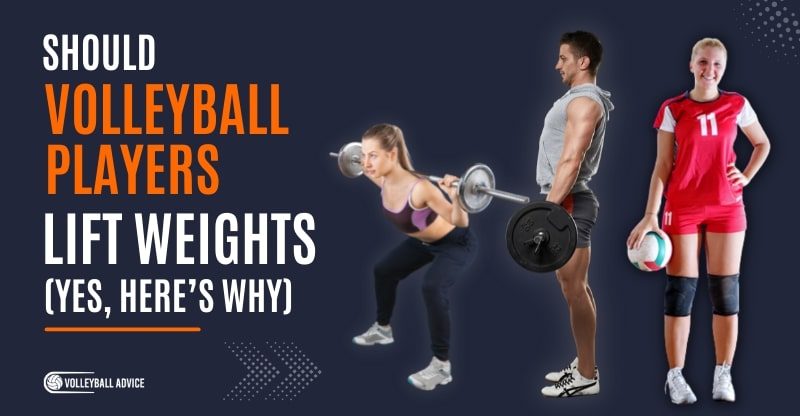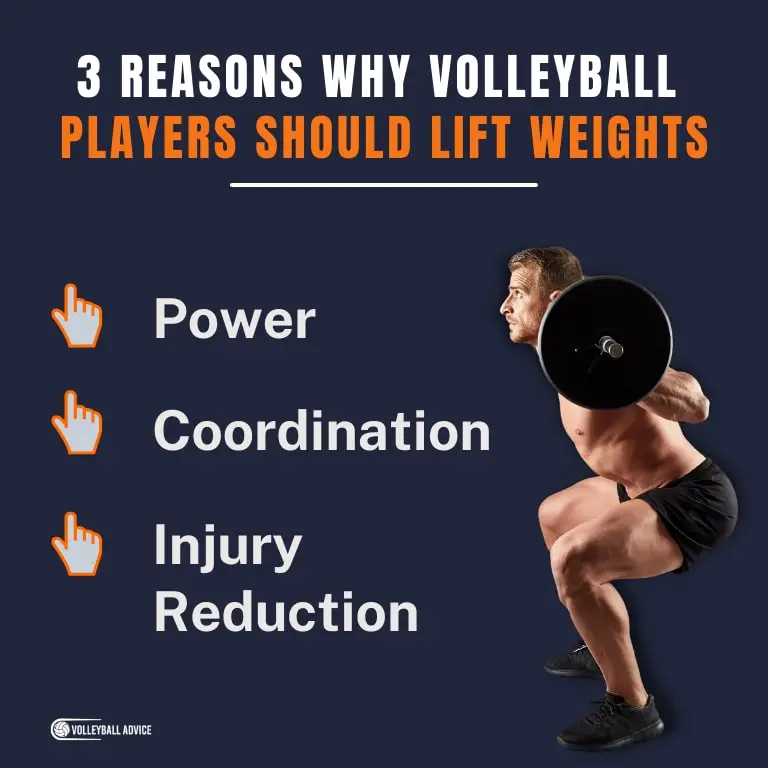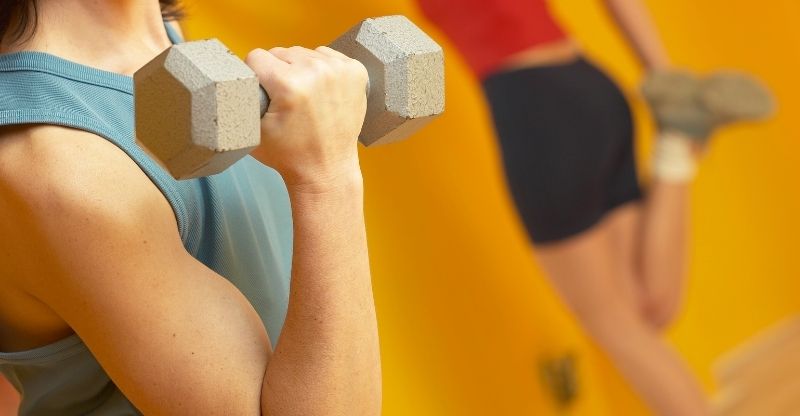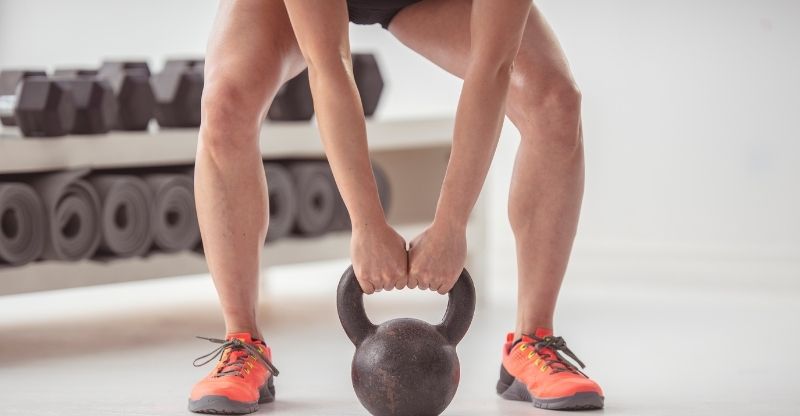Should Volleyball Players Lift Weights (Yes, Here’s Why)
Volleyball athletes tend not to carry a lot of muscle mass, which could raise the question, should volleyball players lift weights? The answer is absolutely yes, if they want to have better power, coordination and longevity in playing.
Below I will break down how weight training will help volleyball players, when to start training and what to focus on in training sessions.
3 Reasons Why Volleyball Players Should Lift Weights
The main goal of resistance training for volleyball is to increase power, coordination and for injury reduction, hopefully increase the time you are healthy and able to play.
Reason #1: Power
Power is a key part of volleyball as it relates to the rate someone develops force, which translates to how fast they can move. Someone who can develop force faster will be able to move faster around the court, but also jump higher and hit harder.
When it comes to jumping higher, whether body weight training or using external weights, significant improvements in jump height were shown from resistance training as it will impact this rate of force development and overall strength.
More specifically certain deadlift training programs and squatting training programs have each shown 7%+ increases in jump height.
Reason #2: Coordination
Coordination refers to the ability to contract and relax muscles the appropriate amount at the right time to create movement.
Through strength training there can be improvements in coordination and control of the limbs. This is relevant as it can lead to improvements in movement patterns.
Squatting, for example, is a movement pattern required for defensive position as well as for jumping. Coordination of the arms is important for serving, setting, blocking and hitting.
Coordination of the arms also plays a role in jump height. Multiple studies have shown that improving the coordination of arm swings can increase jump height by 15% or more.
For a more in depth look at coordination read How To Improve Coordination & Balance In Volleyball
Reason #3: Injury Reduction
There are many factors that contribute to injury reduction. Some major ones that can be impacted through resistance training are overall strength, joint mobility and stability, and proprioception.
Overall strength has many roles to play for volleyball players, however the strength of the shoulder stabilizers is especially important.
Over time, volleyball players will take thousands of swings. Each time they swing, it becomes the responsibility of the muscles of the upper back to slow the arm down at the end.
This puts significant stress on these muscles overtime and can lead to overuse injuries and posture adjustments that create injuries in the back and hips.
Through strength training the shoulder stabilizing muscles and reducing imbalances in muscles in this area can have a positive effect on reducing the chances of such injuries occurring.
For a breakdown of the shoulder stabilizing muscles involved read Muscles Used in Vollebyall
For a more in depth look at maintaining health shoulders read 5 Shoulder Exercises for Volleyball Players
An important governing factor in the range of motion the brain allows at a joint to move through, is how stable and therefore safe it is to move through extreme ranges of motion.
To unlock this mobility, there needs to be adequate strength and coordination in the stabilizing muscles of the joint.
An example of this is the ankle joint. It can be restricted in movement because of tight muscles in the calf, it can also be limited because of poor strength and control of the muscles in the lower leg and foot.
For volleyball players adequate ankle mobility is very important. Limited ankle mobility is associated with many lower body injuries and will alter the biomechanics of how they land from jumping.
Proprioception also known as kineasthesia is the ability for the body to sense movement and position of limbs without the use of vision. Strength training helps with improving proprioception as it is improved through regular movement.
This understanding of where and what is happening in limbs and joints helps the body with coordination of muscle contractions and reduces the chances of injury.
When Should Volleyball Players Lift Weights?
When discussing lifting weights what is appropriate depends on two factors: chronological age and training age.
Chronological age is important as volleyball players younger than 14/15 years old haven’t reached the same levels of physical and mental maturity as players older than 14/15. poppromos.com
For athletes in their early teens the focus should primarily be physical literacy and general athleticism. For people in this age range, it is important to foster a desire and confidence to be continually active through life and too much structured activity can lead to psychological reasons for leaving sport.
That said for some focused young teens some strength training can be appropriate. In these situations the focus would mostly be, coordination and balance, proprioception, and strength training for general athleticism. The intent is to create a good general athletic base at this age as it reduces the chances of future injury.
The following categories are ranges of training ages, how long someone has been weight training, which people start at different chronological ages.
Novice
Novice refers to people who are new to lifting weights and strength training. To see results from workouts, it is important to follow some structure. For this reason the chronological age range people could be introduced to strength training is usually at least 14/15 years old, or when someone starts to get more serious about their sport.
Athletes in the 14/15 – 17/18 and people new to strength training should focus on general strength and movement technique. This will reduce chances of future injury. This also provides a solid foundation for power development, plyometric exercises and other high force or high speed movements.
Intermediate
Depending on how frequently someone is resistance training, someone may move into this stage within a year to a couple years of starting strength training. Most competitive youth volleyball players 16 – 19 years old are in this category of training.
This would also be the training age that describes recreational players who have experience with weight training for a few years, but perhaps never tailored to volleyball.
This is the stage where developing attributes that are important for volleyball becomes more important. In this stage exercises for injury reduction are still important. However there should be a solid foundation of the fundamentals of strength training, allowing it to be safe to lift heavier loads and movements to be done at higher speeds.
These heavier loads and higher speeds will still develop strength but will also be an introduction to power exercises and plyometrics, starting to stimulate adaptations in the body that are favourable to volleyball.
For a more in depth look at these kinds of exercises read Power Exercises for Volleyball Players (Sample Workout) or How To Jump Higher in Volleyball (Science Backed)
This is also the stage where youth in their late teens who want to play at higher levels, will be preparing their body for the demands of playing with more elite competition. Weight training for these kinds of players should also be mixed with education about recovery and other strategies for maintaining their longevity within the sport.
During the late teens the idea of sport specification can be introduced as well, helping athletes understand their body will adapt differently to different ways of training. And so, the focus on workouts is to prepare them specifically for the demands of volleyball.
Experienced
Experienced lifters have multiple years of weight training experience. The majority of people in this category would be varsity athletes who have been strength training since their mid teens, and professional athletes.
Through strength and power exercises continued power development, injury reduction and longevity is enhanced. This is also a stage where players may seek high individualized programs, to create the specific improvements needed for their body and position.
How Often Should Volleyball Players Lift Weights?
The frequency someone lifts weights will depend on if it is in season or off season.
As a general guideline, there should be 48-72h between weight training sessions of the same type. This usually results in 2-4 training sessions per week.
In Season
Too much stress and load on the body can result in fatigue and loss of performance. Therefore it’s more beneficial to make sure there is adequate recovery than to add weight training to someone’s schedule in season.
For example if someone practices Mondays Wednesdays and Fridays, possibly they could weight train on Tuesdays and Thursdays, 2 sessions per week, leaving 48 hours between their weight training sessions.
This could be too much, depending on intensity of the practice sessions and if there are games on Saturdays and Sundays. Possibly Thursday needs to be a rest day and 1 day of full body weight training is all that would be beneficial while in season.
In season the most important factor to determine how much weight training is done is overall fatigue.
Off Season
While fatigue is still important to be aware of, the amount of weight training done in the off season comes down to someone’s goals.
As someone plays higher levels preparing for the upcoming season becomes more important and could mean doing some preparation almost every day. This could mean 4+ weight training sessions a week.
In a situation where there are that many training seasons, the focus of each session will change through the week so that there is still 48-72h between sessions focused on the same thing.
How the focus could change would be doing what’s called a split, for example upper body and lower body. The advantage of this is that entire workouts can focus on the lower body, while the upper body is “resting” and then the lower body can “rest” while the upper body is trained the next day.
This still leaves 48h for recovery between workouts of the same focus but more total time focused on each area. When using splits to increase the number of workouts per week, it is still important to make sure adequate recovery is happening as that is where improvement comes from.
For younger volleyball players or people who are less elite, 1-3 full body workouts may be sufficient to reach off season goals.
Off season is a time for physical recovery and preparation as well as psychological. It is important that the amount of structured training matches the commitment level someone has to the sport.
Types of Exercises Volleyball Players Should Incorporate
Plyometric
Plyometric exercises are ones that train the stretch shortening cycle, a key part of helping you jump higher.
Counter Movement Jumps
It requires little equipment and is easy to perform safely making it a great introductory plyometric for intermediate training age people.
How To
- Stand with your feet shoulder width apart and arms raised above your head
- Drive your arms down pulling yourself into a squat
- Immediately explode up by driving your feet into the floor and getting as tall as you can
- Land the jump as quietly as you can by dropping back into a squat
- Immediately explode off the floor again
This exercise is a great exercise to work on jump technique. As mentioned above improving the coordination of the arms in jumping alone can have a significant impact on jump height. It will also help volleyball players through training muscular power in the lower body.
Power
Power exercises are ones that train the rate of force production at higher speeds. The emphasis of these exercises is to move ballistically.
Overhead Ball Slam
This is an exercise to build power in the arms and core. It requires only a 2-8lb ball and a place to throw it.
How To
- Stand feet shoulder width apart with a med ball in your hands
- Lift the ball overhead and throw the ball down as hard as you can, like you were spiking the ball
It translates well to hitting as it works specifically on the ability to drive the arm from overhead down and connecting the arms and core to produce rapid force.
Trap Bar Jumping Squats
This would be a power exercise more suited to experienced lifters. It requires comfortability with jump technique as well as using weights. It would be important that someone is comfortable deadlifting 5x the weight of the trap bar before starting to do trap bar jumping squats.
How To
- Load a trap bar with no more than 20% of your max trap bar squat
- Hold the handles and perform a jump for a squatting position
- Land as quietly as possible
This exercise will help with power production, especially power for jumping. By training with increased resistance, athletes can learn to move more load that body weight at quick speeds.
Strength
Strength training exercises improve overall muscular strength, providing a foundation for power development and reducing the chances of injury.
Deadlift
Deadlifting is an exercise that build strength in the lower body and core posture. Once someone masters technique, they can continually add weight to get stronger and stronger.
How To
- Hold a bar or dumbbells in your hands while standing tall
- Squeeze your the air out of your armpits or if you are using a bar, try to bend it around your legs
- Push your hips for the wall behind you
- Push the ground away to stand tall
Deadlifting develops strength in your hip hinge, which is a key part of how high you can jump. Hip hinging is a fundamental part of producing power for a jump. By mastering this movement at slow speeds, athletes are able to progress to power exercises that use these movement patterns like kettlebell swings, olympic lifts, trap bar jumps and plyometrics.
Squat
Improves your leg strength, especially for jumping.
How To
- With feet shoulder width apart, pull yourself into the squat like you are sitting on a chair
- Push the ground away to stand back up tall
- Try to keep your torso more vertical than the shins
Most volleyball movements use the squatting pattern, defensive position, jumping to serve, block, set, hit and moving laterally. By building strength in the squat, volleyball players will become less fatigued in defensive posture, and be able to jump higher.
Pull Ups
Pull ups are an upper body strength exercise the requires pulling your chin up over a bar from hanging. As it does require significant upper body strength, it may mean novice and intermediate lifters will need assistance.
How To
- Grab the bar wider than shoulder width with your palms facing away from you
- Imagine you are bending the bar over your head as you drive your head up
- Control down
This exercise helps volleyball players by improving the function and stability of the shoulder stabilizing muscles in an overhead position, important for slowing down the arm and injury reduction. It will also build strength in the lat muscle which can increase the power of the spike.
Other Strength & Conditioning Articles
- Sprint Workouts For Volleyball (6 Examples)
- 5 Best Ab Exercises for Volleyball Players (Sample Workout)
Final Thoughts
In summary, competitive and recreational players will all benefit from lifting weights. These benefits will include improved coordination, power and reduce chances of injury.
How often and the focus of Provigil weight training depends on age, weight training experience and whether someone is in season or in the off season. But, incorporating a combination of strength, power and plyometrics exercises will improve on court performance.
About The Author
Ian started his strength and conditioning career working with elite youth volleyball athletes. Before coaching, he completed a BSc in Biomechanics at the University of Calgary. He has over a decade of experience working as a kinesiologist and strength and conditioning coach, with teens to octogenarians in positions with community gyms to elite sport. Outside of coaching, you can find Ian learning new sports, skiing, river surfing, hiking, and traveling. If you have questions or are interested in opportunities to work with Ian, connect with him via Instagram, Linkedin, or Website.




